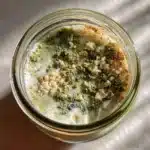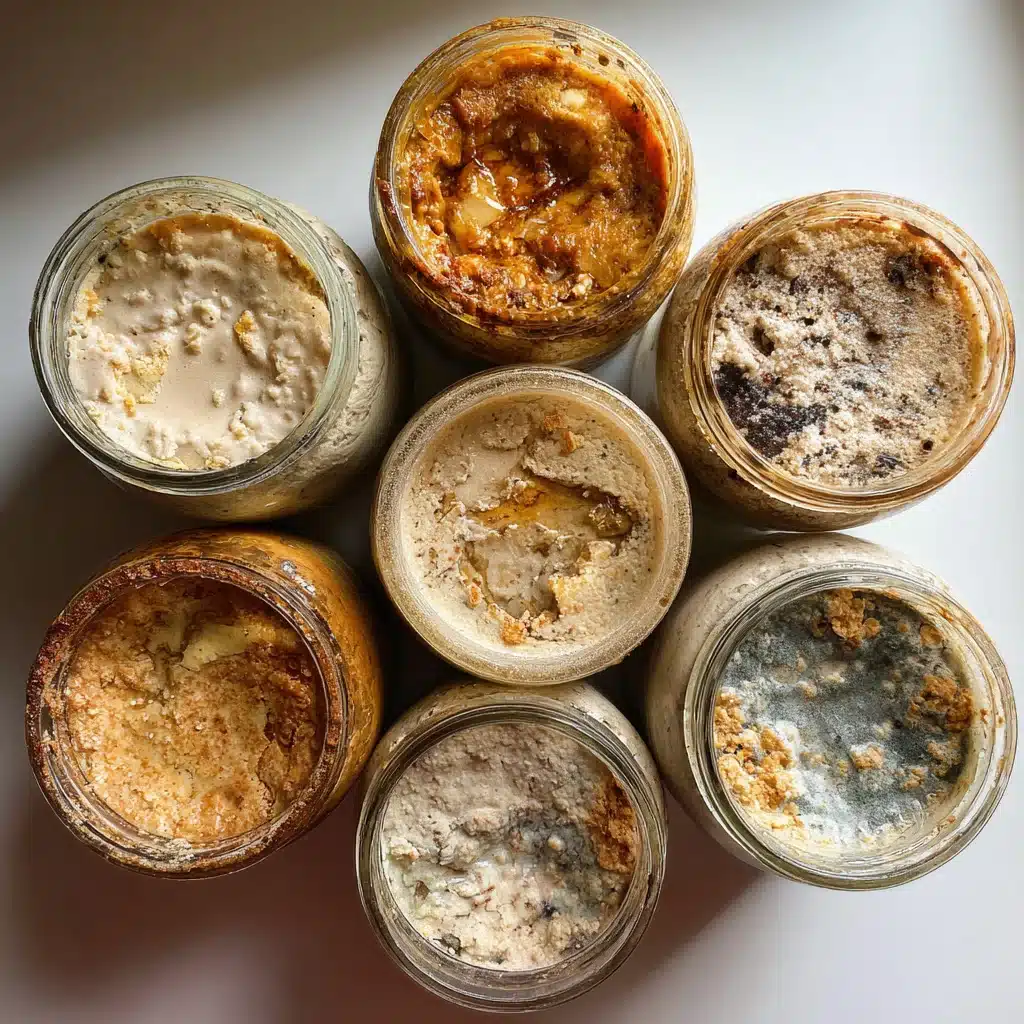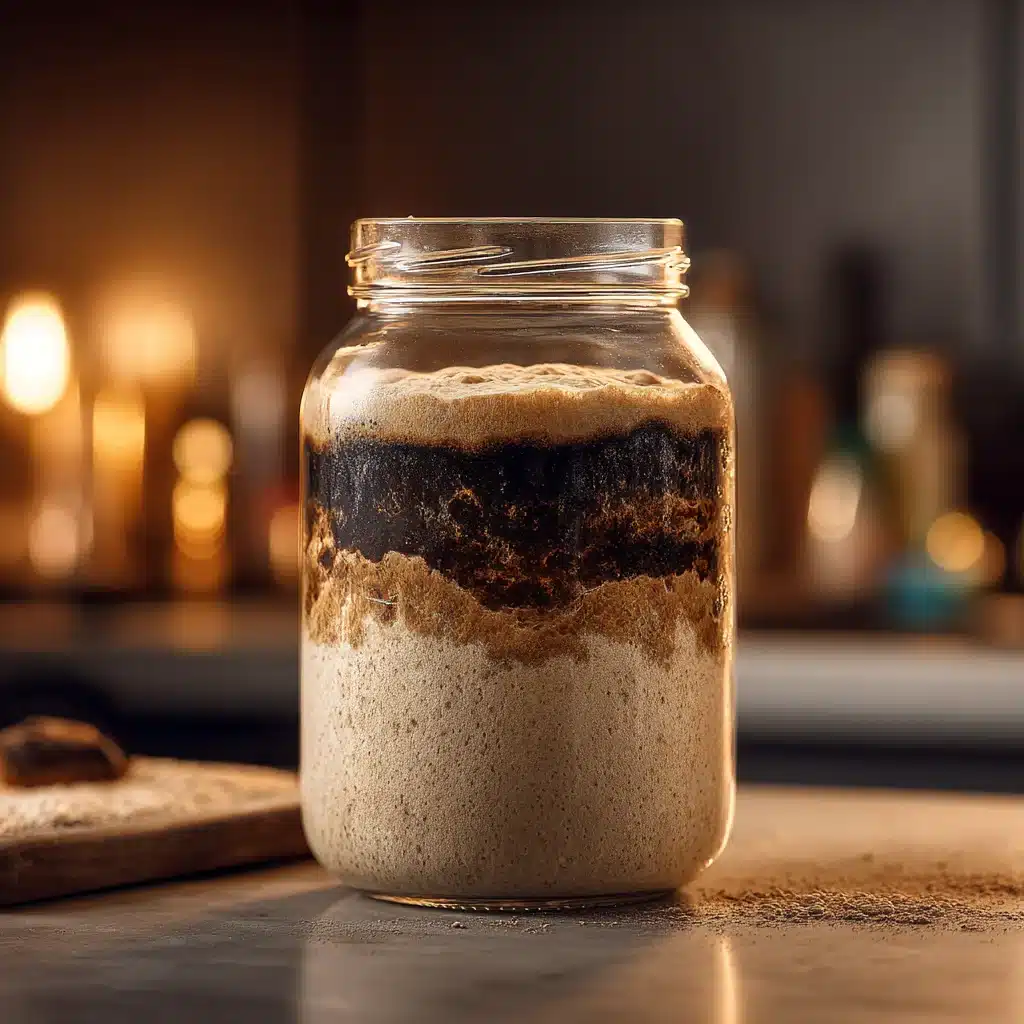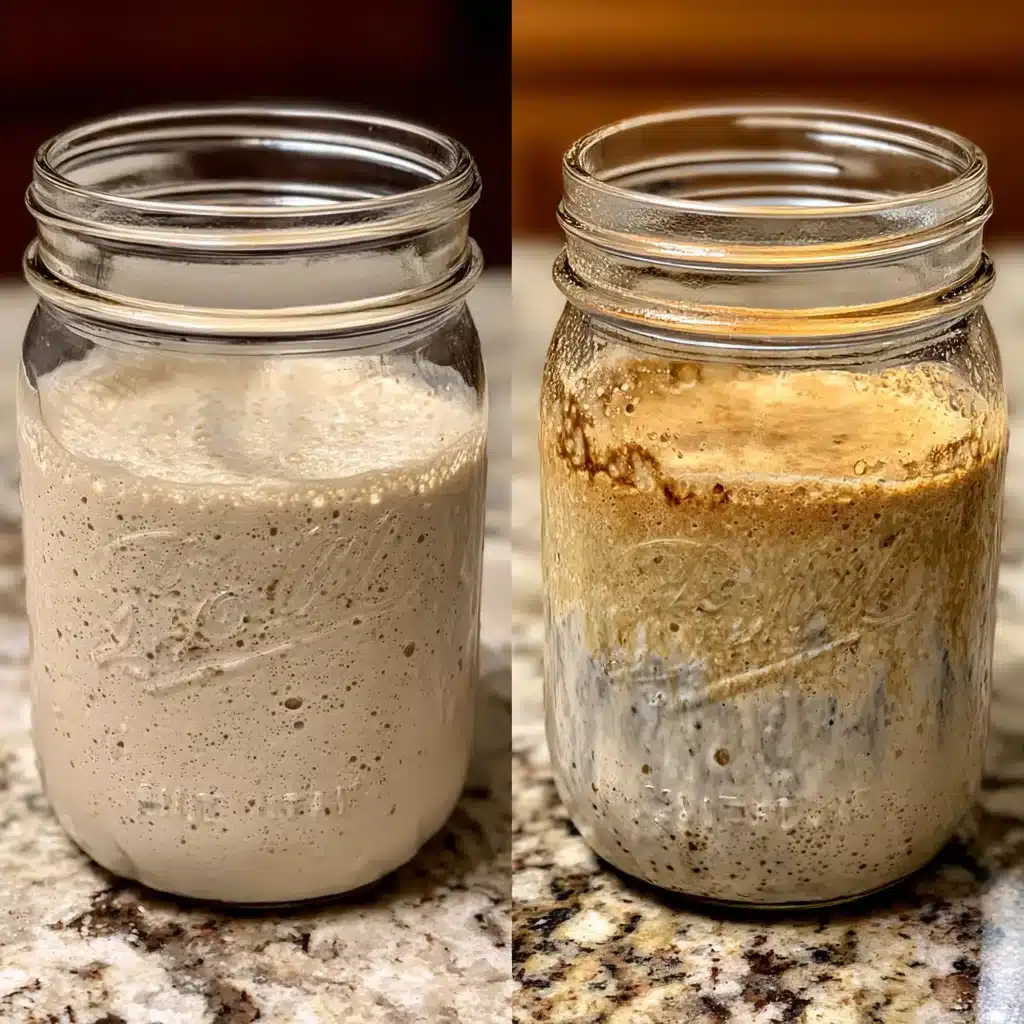Bad Sourdough Starter Images: What to Look Out For Before Baking
When it comes to sourdough, your starter is everything. But what happens when it looks… off? This guide walks you through what bad sourdough starter images reveal, before you bake with a spoiled mix. From color changes to scary textures and strange smells, we’ll help you read the signs of a starter gone wrong. Whether your sourdough bread isn’t rising or your jar of Clementine is starting to smell like acetone, you’ll know exactly what to do next.
The Day I Almost Baked With a Bad Starter
I still remember the first time I looked down at my jar and thought, “Wait, was that green before?” I was just about to prep dough for my usual Tuesday morning boule when I saw a fuzzy streak growing along the side of the glass. It wasn’t flour dust. It wasn’t bubbles. It was mold. And I almost missed it.
My sourdough starter had been acting funny, slightly runny, kind of flat, not its usual bubbly self. But I chalked it up to the cooler weather in Mendocino. The truth? It was going bad, and I didn’t catch it early. That batch could’ve made me sick.
So today, I’m sharing the things I wish I’d known sooner, what a spoiled sourdough starter looks like, what bad sourdough starter images show, and how to tell the difference between harmless hooch and dangerous mold.
I’ve taught sourdough workshops from Alaska to Austin, and the most common question is always: “How do I know if my sourdough starter is bad?” The answer lives in the jar itself, if you know how to read the signs.
On one hand, fermentation is wild and unpredictable. On the other, a moldy sourdough starter is never something to “just try anyway.” You wouldn’t drink milk with fuzz on it, right? Don’t bake bread with it either.
You’re not alone if your sourdough starter looks runny or your sourdough bread isn’t rising. That doesn’t mean it’s beyond saving, but it does mean we need to take a close look.
In the next section, we’ll break down the visual cues that tell you it’s time to pause, observe, and maybe say goodbye to your starter. Get ready, we’re going to look at the ugly truth.
Print
Bad Sourdough Starter Images: 5 Alarming Signs to Know
Description
Visual guide for spotting a bad sourdough starter before baking. Learn what mold, bacterial contamination, and poor fermentation look like.
Ingredients
1 sourdough starter (at any stage)
Filtered water
Whole wheat or rye flour (for troubleshooting)
Clean glass jar
Spoon or spatula
Phone (for image tracking)
Instructions
1. Examine starter surface for unusual colors or fuzzy mold.
2. Check for strong odors: acetone, rot, or vomit indicate bacterial overgrowth.
3. Look at texture: runny, separated, or crusty top layers.
4. If unsure, take a daily photo for comparison.
5. For recovery, discard and feed with 1:2:2 flour-water ratio.
6. Place in warm spot and monitor rise.
7. If mold is present, discard completely and sterilize tools.
Notes
Don’t ignore early signs—early action can save your starter.
Always use clean tools and filtered water.
Photographs help track slow spoilage or dehydration.

What Should Your Sourdough Starter Not Look Like?
When it comes to identifying problems in your jar, bad sourdough starter images are your best teacher. Don’t ignore what your eyes are telling you. A spoiled starter reveals itself through strange colors, odd layers, and unappetizing textures, and these signs matter more than timers or temperatures.
Mold, Hooch, and Color Changes
Let’s talk mold. It’s the most dangerous warning in any collection of bad sourdough starter images. If you spot green fuzz, black streaks, or a pink film on top of your starter, it’s time to throw it out. Mold often appears along the jar’s rim, inside the lid, or in swirls across the surface.
You might also notice hooch, a thin liquid that pools at the top or in the center. A little hooch is okay, it just means your starter is hungry. But in many moldy sourdough starter photos, dark or discolored hooch accompanies bacterial imbalance. That’s when it turns from harmless to harmful.
Healthy sourdough starter should look off-white and bubbly. If it starts to turn grey, pink, or orange, you’re in danger zone territory. These color shifts are red flags, especially when they show up alongside strong smells.
I break this down further in my sourdough starter guide, the visual gallery there helps you compare good vs. bad.

Textures That Spell Trouble: Runny, Crusty, or Separated
Many people ask, “Why does my sourdough starter look runny?” This shows up often in bad sourdough starter images across forums. A watery texture, paired with low rise and sour smells, usually points to yeast imbalance or missed feedings.
Separation is another warning. When you see thick goo on the bottom, dark liquid in the middle, and crust on top, that’s not fermentation, that’s a failing culture. I recommend visiting this clever carrot sourdough routine for recovery tips.
If you’re unsure what you’re seeing, take a daily photo. Your collection of bad sourdough starter images can help you track early warning signs and prevent baking with contaminated culture.
What Bad Bacteria on Sourdough Starter Look Like
Some signs of a spoiled starter aren’t just visual, they’re bacterial. The difference between a healthy and contaminated culture isn’t always dramatic in appearance. That’s why pairing what you see with what you smell and observe is key. In fact, bad sourdough starter images often miss what your nose picks up immediately.
Disgusting Aromas: From Vomit to Nail Polish Remover
If your starter smells like vinegar or even a little sharp after a feeding, don’t worry, that’s normal. But if the smell makes you pull away from the jar, take note. Common signs of bad bacteria include a scent similar to vomit, ammonia, acetone (like nail polish remover), or even rotten meat.
These are not quirky traits of sourdough, they’re signs of contamination. While not all bad bacteria are visible in bad sourdough starter images, foul odors are almost always the first warning.
I once had a starter that looked fine but smelled like chemicals. A quick check with a spoon revealed black specks under the surface, it had gone bad from the inside. Don’t let a seemingly normal top layer fool you.
A useful way to judge health is by comparing smell with rise and texture. If the smell is off and the starter isn’t rising, something’s gone wrong.
When Your Sourdough Starter Is Runny, Inactive, or Separating Weirdly
Another red flag is inactivity. If your starter sits flat for hours, has no visible bubbles, and remains runny despite feedings, your yeast may be outcompeted by unwanted microbes.
In these cases, bad sourdough starter images show soupy texture with dense sediment and zero life on the surface. If it’s been more than 24 hours with no rise and you’re seeing liquid separation, it’s time to assess. A healthy starter will expand within 4–8 hours after a proper feed.
Even if there’s no visible mold, ongoing inactivity means your starter’s internal balance is broken. I’ve found that a detailed health check, including smell, texture, and rise, tells more than any single photo.
Also, some signs may indicate broader digestive or dietary incompatibilities. If your starter keeps failing or seems overly reactive, explore whether your gut health plays a role. I wrote more about this in my sourdough IBS article and my sourdough health benefits guide.

How to Know If Your Sourdough Starter Is Bad , And What to Do
Once you’ve identified a problem using sight, smell, or texture, the big question is: can it be saved? Many home bakers panic at the first odd whiff or weird color, but not every strange day means your starter is ruined. Let’s break down when to refresh and when to say goodbye, for good.
Can You Save It? When to Toss, When to Troubleshoot
The truth is, not every starter that looks strange is beyond hope. Some of the most dramatic bad sourdough starter images you’ll find online come from beginners reacting to harmless hooch or crust. If your starter smells pleasantly sour, shows bubbles, and rises, even a little, it’s likely alive and just needs care.
But if you spot mold (especially colorful or fuzzy), smell chemicals or rot, or see unusual pink, orange, or grey streaks, toss it. These are signs of bacterial or fungal overgrowth that can’t be fixed by feeding.
If your issue is simply inactivity or sluggish rise, try resetting your starter. Discard all but one tablespoon, feed it with a 1:1:1 or even 1:2:2 ratio of flour to water, and place it in a warm spot. You’d be amazed how many so-called “dead” starters bounce back in 24 hours.
Still unsure? Try comparing your starter to reliable visuals. Our archive of bad sourdough starter images can help you visually identify red flags.
Starter Not Rising? Resetting It the Right Way
If your sourdough bread starter is not rising, first double-check your flour. Bleached or overly refined flours can slow activity. Next, try filtered water, chlorine can inhibit wild yeast growth.
Feeding schedule matters too. A runny starter often means you’re using too much water or feeding too infrequently. Stick to a consistent ratio, use a clean jar, and observe closely over 48 hours.
You can also try boosting your starter with a small amount of whole wheat or rye flour, both are nutrient-dense and yeast-friendly.
And if you’re navigating dietary issues like bloating or gluten sensitivity, consider switching to a low FODMAP sourdough bread routine. It may be your gut, not just your jar, that needs a reset.
If you’ve been feeding your starter for weeks and it still won’t behave, you might need to start fresh. There’s no shame in retiring an old culture and beginning again with confidence. I explain more in my guide on is sourdough bread gluten-free for folks navigating both baking and health hurdles.
Remember, sourdough is meant to nourish, not frustrate. If it’s stressing you out or filling your fridge with uncertainty, it’s okay to step back and regroup.
Conclusion
Your sourdough starter is a living, breathing culture. It deserves attention—and sometimes, a fresh start. By studying bad sourdough starter images, understanding the smells and signs, and trusting your instincts, you’ll learn what not to bake with.
Mistakes happen. Starters collapse. Mold sneaks in. But each batch teaches us something valuable. If your starter’s acting up, don’t toss the hobby, just toss the jar, clean up, and start again. A beautiful loaf is only a few feedings away.
Frequently Asked Questions About Bad Sourdough Starter Images
What does a spoiled sourdough starter look like?
A spoiled starter may show mold (green, pink, black, or fuzzy), strange color changes like orange or grey, and lack visible bubbles. In many bad sourdough starter images, you’ll also see separation into layers, with a dark hooch floating on top and thick sludge on the bottom. A truly bad starter looks lifeless and sometimes frightening.
How would I know if my sourdough starter is bad?
Use your senses. If your sourdough starter smells like chemicals, rotten eggs, or vomit, it’s likely gone bad. Visual cues like mold, streaks, or unusual colors confirm it. A healthy starter should rise after feeding and smell pleasantly tangy. If it’s flat, discolored, or stinks, don’t bake with it.
What do bad bacteria on sourdough starter look like?
Bad bacteria are often invisible at first but may cause sudden sour smells, odd textures, and color shifts. You’ll often see symptoms like slimy separation, a greyish tint, or specks of black inside the mixture. Comparing your starter with clear bad sourdough starter images helps spot the difference between normal fermentation and harmful spoilage.
What should your sourdough starter not look like?
Your starter should never look moldy, dry and crusty, overly runny, or streaked with color. It also shouldn’t sit still for 24+ hours without bubbling or rising. If it’s separated into strange layers or shows discoloration, refer to trusted images to check for spoilage signs.
Why is my sourdough starter not rising?
Several reasons: it may be underfed, over-hydrated, using bleached flour, or exposed to cold. If your starter is runny or separated and still not rising after feedings, it may have a microbial imbalance. Reset with a firmer flour ratio, filtered water, and warmth. If no change, you may be dealing with contamination.

